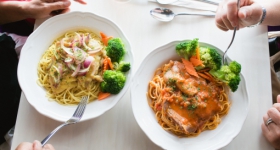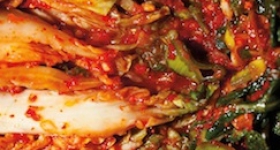Web Exclusive Video: How to make jung
Yield: 20 servings
Cooking soundtrack: “Chinese New Year” by Mulatu Astatke & The Heliocentrics from Inspiration Information 3
Jung (also called “zongzi” in Mandarin) is a simple, balanced and complete meal of rice, protein and vegetables wrapped in bamboo leaves. For centuries, jung has provided working people in China and southeast Asia with inexpensive portable food that holds well without refrigeration.
Like tamale-making in Mexico, jung-wrapping is a skill passed down through generations. We learned to make jung from a friend’s mom two years ago and since then have remixed the recipe in endless variations. For our engagement party, we created Afro-Asian jung to symbolize our union: healthy, scrumptious, and made in the spirit of unifying our two cultures.
We both came to the table deeply rooted in our cultural food ways and excited to create something new together. Our tastiest meals are microcosms of our histories, remembered through our grandmothers’ kitchens. When making Afro-Asian Jung, we set out to illuminate the shared past of Asians and African Americans who fought side by side in the social justice movements of the 1960s and 1970s, and to honor our great-grandfathers who toiled as agricultural laborers to build this country’s wealth.
While glutinous or sweet rice is traditionally used to give jung its trademark stickiness, we used three kinds of rice to add color, texture and depth of flavor. For additional filling, we used peanuts (a staple of African and African American cooking as well as a symbol of long life for Chinese), black-eyed peas (a symbol of good luck for African Americans), and shiitake mushrooms (a symbol of longevity in Japan and China).
In a large pot over high heat, bring 4 quarts water to a boil. In batches of 4 or 5, boil the bamboo leaves until soft, about 2 minutes. After all the leaves are boiled, rinse well and transfer to a container, and cover with fresh water. With scissors, cut the leaves widthwise, about 1/4-inch below the stem. Discard stems (Step 1).
Drain all the rice and combine in a large bowl. Add one teaspoon salt and three tablespoons oil and set aside. Drain the black-eyed peas and set aside. Drain the shiitake mushrooms and cut into halves.
In a medium-size saucepan over medium heat, sauté the onion with two tablespoons oil until caramelized, about 10 minutes. Add the peanuts and 1/2 teaspoon salt and cook until the peanuts start browning, about five minutes. Transfer to a bowl.
Arrange all the ingredients on a worktable.
To make jung
Line up two bamboo leaves lengthwise, vein-side down, placing the right leaf’s left edge flush against the left leaf’s vein. Fold the pointed end up, one third of the length of the leaves (Step 2). Then fold the leaves in half lengthwise (Step 3). Create a pocket for the filling by opening up the fold of the last two leaves on the right (Steps 4 and 5).
Holding the pocket at its deepest corner (Step 6), add ingredients in the following order: two tablespoons rice, one tablespoon onion-peanut mixture, one tablespoon black eyed peas, one mushroom half, and one more tablespoon rice (Step 7).
Fold the leaves over the pocket (Step 8) and extend the leaves’ ends beyond the pocket’s edge by one to three inches. The jung should be tightly wrapped, resembling a three-sided pyramid.
Fold down the leaves’ sides in order to make the pyramid’s last corner (Step 9). Take the section of folded leaf that overextends the jung and fold it over to one side of the jung (Step 11). This is the last fold to close up the corner. It is important that enough of the leaf overextends the jung in order to make these last folds.
During this phase of wrapping, parts of leaves may crack open. If the crack is small (one inch or less), use another leaf to cover the crack. After making the three-sided pyramid shape, layer the extra leaf upon the crack and wrap the rest of the leaf around the pyramid.
Tightly wrap a strand of string around the jung, leaving four to five inches loose to make the last knot. Start wrapping to secure the last corner fold; this helps the whole jung stay together as you wrap the rest of it (Step 12). Make a tight double knot (Step 13).
Cooking
In a large pot over high heat, bring four quarts fresh water to a boil. Drop the jung into the boiling water, cover, and cook for two hours. Extra jung can be frozen and re-boiled later. While the jung are boiling, combine all dipping sauce ingredients in a small bowl.
Remove the jung from the water and let cool for 20 to 30 minutes. Guests can cut the string with scissors and unwrap the jung onto their plates, or you can unwrap and serve one jung per person. Discard the string and leaves. Spoon dipping sauce onto the jung to taste.
Bryant Terry is an eco chef, food justice activist, and author of Vegan Soul Kitchen: Fresh, Healthy, and Creative African-American Cuisine and Grub: Ideas for an Urban Organic Kitchen. Jidan Koon is an artist, community organizer, and senior fellow at the Movement Strategy Center in Oakland, CA.









Comments